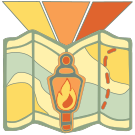Learn About Association: Difference between revisions
imported>Jacob Robertson (Created page with "== Overview == {{Trail Info Box |Name={{PAGENAME}} |image=Learn-About-Association.jpg }} === What are Trails? === {{Trails Overview}} === What is Association? === {{:Association Overview}} === Where will this Trail take you? === This trail is designed to take you to a place where you have a basic understanding of the Beacon of Adaptation, including the Lenses of Impermanence, Non-Attachment, Non-Seeking, Non-Aversion and Equanimity, as well as the Credo...") |
(No difference)
|
Revision as of 19:18, 20 July 2023
Overview
| Trail: Learn About Association | |
| Trail: Learn About Association | |
|---|---|
| Landmarks | Observe Duality and Connectedness Observe Impermanent People Observe Emotions From Outside |
What are Trails?
A Trail in the context of Everyday Enlightenment is a curated journey of self-discovery and personal growth. It is a structured way of traveling through concepts and practices and is designed to guide you towards mindfulness and deeper understanding. Using a Trail helps you systematically navigate and explore the vast landscape of meditative insights, providing you with achievable goals and practical techniques to integrate these insights into your everyday life.
What is Association?
Where will this Trail take you?
This trail is designed to take you to a place where you have a basic understanding of the Beacon of Adaptation, including the Lenses of Impermanence, Non-Attachment, Non-Seeking, Non-Aversion and Equanimity, as well as the Credo of Embrace the Change. Once you've completed this trail, it is recommended you read through the content on the Adaptation page.
Step 1 - Learn About G
During this step, you will get a chance to see the difference between seeing something as solid, steady, permanent as opposed to transient, ephemeral, impermanent. This is the first step in becoming a Learner in the Beacon of Adaptation.
Lookouts
- Notice Things Appear Solid: When you touch things, they appear solid, like they could last forever.
- Think About How Things Won't Last: We know nothing lasts forever, but try to really think about how true that is.
Skill: The Impermanent Water
Checkpoints
- Notice Things Appear Solid: Were you able to notice how much we rely on the idea that things are solid and reliable?
- Think About How Things Won't Last: Did you feel a shift in perception as you thought about the water's impermanence, and even how the bottle itself is going to change and decay over time?
Step 2 - Learn About G
During this step, you'll experiment with cravings and how they affect your thoughts and emotions. Recognizing Craving is one aspect of preparing to understand Non-Seeking.
Lookouts
- Discovering Craving: Get ready to study your craving and understand what it's like and what it's made of.
- Being Pulled vs Thinking: Try to notice the difference between your craving (being pulled) and the mental thoughts that run through your head ("That chocolate looks so good").
Skill: as
Checkpoints
- Discovering Craving: Did you get a chance to really notice that there is a true craving to experience?
- Being Pulled vs Thinking: Were you able to distinguish between the Pulling and the Thoughts?
Step 3 - Learn About G
In this step, you will practice both experiencing and being patient with aversive sensations.
Lookouts
- Feeling the Aversion: It's important to take time and really observe what Aversion feels like.
- Being Patient: It doesn't matter how long you're patient for, what's important is practicing, and noticing what it feels like to be patient.
Skill: a
Checkpoints
- Feeling the Aversion: Did you get a chance to observe what it's like to really want something to be over, and how your mental state changes the longer you sit with that?
- Being Patient: Were you able to feel the mental state of being patient, and resting with an aversive sensation?
Destination
Congratulations, if you've completed these three Skills, and reviewed the Checkpoints, you are one Trail further along in your practice. Now that you have a basic idea of the concept, it's recommended you read through the article about the Beacon of Association, and see if it starts to click with you. Then, look for other Trails and Skills that are in the Learning Milestone that can assist you further.
Resources
To learn more about these concepts, see the following articles.
- t
- b
- d
